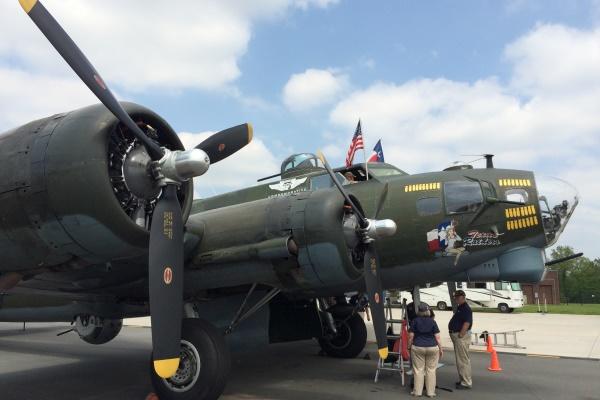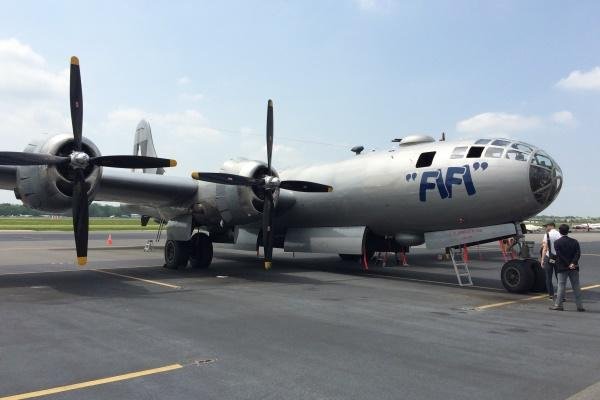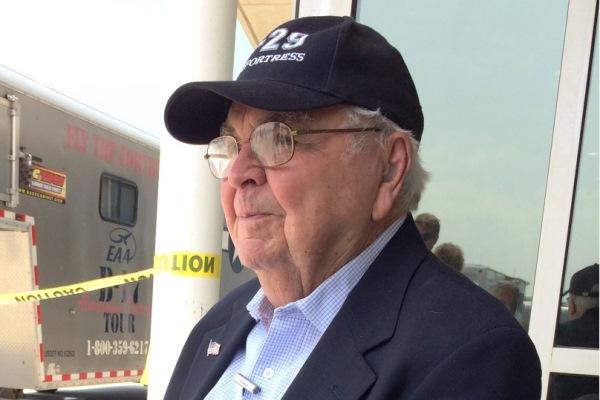World War II-era planes will perform a flyover of the National Mall in Washington, D.C., on Friday to mark the 70th anniversary of the allied victory in Europe, or V-E Day.
The event, dubbed the Arsenal of Democracy Flyover, will feature some 55 vintage aircraft, including the iconic P-51 Mustang fighter and the B-17 Flying Fortress bomber. The 50-minute airshow is set to begin 12:10 p.m. local time and will follow ceremonial events at the World War II memorial.
"We're flying a huge array of aircraft, all vintage of World War II," said Nancy Kwiecien, a volunteer with the Commemorative Air Force, a Texas-based nonprofit that owns and operates some of the planes participating in the event. "They will be staged in chronological order according to the war."
The flyover is being sponsored in part by aerospace and defense companies, including Boeing Co., General Electric Co. and Northrop Grumman Corp., among others.
The formations will kick off with trainers and biplanes representing the period leading up to the war, followed by P-40 Warhawk aircraft marking the attack on Pearl Harbor, B-25 Mitchell bombers representing the raid on Tokyo, and B-17 and B-29 bombers marking the air wars in Europe and the Pacific, Kwiecien said. The flyby will culminate with a P-51 missing man formation, she said.
"It's going to be stunning," she said. A detailed lineup of the scheduled formations can be found on the event's website, http://ww2flyover.org/flyover-formations/.
Reporters, photographers, history buffs and even a few World War II veterans gathered on the tarmac to view a pair of B-17s, as well as a B-24 Liberator and a B-29 Superfortress during a media day Thursday at the Manassas Regional Airport in Virginia about 30 miles southwest of D.C.
Some attendees climbed into the bellies of the planes to tour their musty, cramped confines. Still others got a chance to ride in the loud, four-engine prop planes as they prepared for the following day. A similar event took place at the nearby Culpeper Regional Airport, where fighters and other smaller aircraft were staging for the flyby.
Kevin Michaels, who volunteers for the Commemorative Air Force as a loadmaster for the army green B-17G named Texas Raiders, said more than 12,700 Flying Fortresses were built during the 1940s, yet only about a dozen or so are flying today.
"It's a labor of love to do this," he said. "It's amazing that any of these aircraft are still around today."
Michaels added, "Texas Raiders is one of the last 20 B-17s ever built. It was built by Douglas under license. It came off the line July 12, 1945, which is right in between V-E Day and V-J Day," he said, referring to the allied victories in Europe and Japan.
Jed Doggett, a B-17 pilot and maintenance officer with the organization, said he has always had a passion for older planes. He noted that he came from the same hometown of Greensboro, North Carolina, as George Preddy, the leading P-51 ace of the war who was shot down on Christmas Day in 1944 in Belgium.
A commercial pilot for United Airlines for his day job, Doggett said the Boeing 787 Dreamliner and other modern aircraft are much easier to fly than the older planes.
"They're a piece a cake. There's nothing to it. I mean, I don't want to say there's no skill involved -- that's not true," he said. "My point of view is that it's a lot of effort to fly these old airplanes … especially tailwheel airplanes. They don't want to go straight down the runway. They don't want to go straight down the taxiway. They want to turn into the wind -- anything but what you would really like for them to do."
Keeping the aging aircraft flying is no small task, Doggett said. Over a two-month period this past winter, for example, maintenance workers and other volunteers with his organization spent more than 3,500 hours on Texas Raiders, he said. Spare parts may be hard to find, but they're generally available, he said.
"Engines are no problem, parts are no problem, props are no problem," he said. "When you get down to sheet metal and airplane parts -- real airplane parts, not pieces that you can replace -- that becomes more difficult. Landing gear are hard to come by. Tires are not as bad as you might think, but they're $4,000 apiece. And it burns over 200 gallons an hour in gas and oil -- it's burning about three or four gallons an hour, so it's not cheap."
Bob Vaucher, a 96-year-old resident of Bridgewater, New Jersey, who retired as a lieutenant colonel in the Army Air Corps, was also on hand to celebrate the anniversary and talk to reporters about his experiences. He flew the B-17, B-24 and the B-29, and received multiple awards, including two Distinguished Services Crosses.
He regaled reporters with some of his war stories, including the time he piloted the first production-model Superfortress the military accepted from Boeing.
"The only reason I was a command pilot on that flight, a captain and myself, a first lieutenant, went to Wichita to pick up this airplane -- first B-29," he said. "He was a captain and I was a lieutenant. He decided that I should fly it because I had 30 minutes more flying time. I had two hours and 15 minutes as a test pilot … and he only had an hour and 45, so the time overruled the captaincy. I was a command pilot on that flight and I never ever was nothing but that."
Vaucher also flew one of eight B-29s on the longest nonstop combat mission of the war -- a nearly 19-hour, 4,030-nautical-mile roundtrip flight from an allied base in India to the Musi River in Sumatra, Indonesia. The waterway led to a high-octane refinery the Japanese depended on to support their aircraft in the South Pacific.
"The mission was to mine the river so freighters, tankers couldn't go up the river and it was beyond our length that we could fly by a considerable amount," he said. "Each of us had to sign a will in the briefing in case we didn't get back. It's kind of daunting to go on a mission where they don't expect you to get back. That's a mind-boggler. That's quite a way to start out a mission. It doesn't have anything to do with the enemy. It has to do with your own capability."
Vaucher said he and his crew dropped their mines at low altitude and turned back. But the excitement wasn't over. On the return trip, the crew had to extinguish a fire that broke out in engine No. 3 and consider crash-landing the plane into the Indian Ocean to avoid running out of fuel over land. When he came in for a landing on base, he heard the engines shutting down.
"We couldn't even measure the gas in the tanks," he said. "Everybody was anxious to see how much gas we had. We came in on fumes."
Vaucher said he was delighted to see so many vintage planes coming together to celebrate the anniversary.
"It's fantastic," he said. "In my wildest dreams, I wouldn't have thought that at the age of 96 I would see every airplane that the Air Force had in World War II fly over the capital of the United States. That's a happening to behold in your lifetime."





























